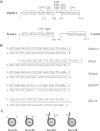Alternative modes of binding of poly(ADP-ribose) polymerase 1 to free DNA and nucleosomes
- PMID: 22854955
- PMCID: PMC3463355
- DOI: 10.1074/jbc.M112.397067
Alternative modes of binding of poly(ADP-ribose) polymerase 1 to free DNA and nucleosomes
Abstract
Poly(ADP-ribose) polymerase 1 (PARP-1) is an abundant nuclear protein that binds chromatin and catalyzes the transfer of ADP-ribose groups to itself and to numerous target proteins upon interacting with damaged DNA. The molecular basis for the dual role of PARP-1 as a chromatin architectural protein and a first responder in DNA repair pathways remains unclear. Here, we quantified the interactions of full-length PARP-1 and its N-terminal half with different types of DNA damage and with defined nucleosome substrates. We found that full-length PARP-1 prefers nucleosomes with two linker DNA extensions over any other substrate (including several free DNA models) and that the C-terminal half of PARP-1 is necessary for this selectivity. We also measured the ability of various substrates to activate PARP-1 activity and found that the most important feature for activation is one free DNA end rather than tight interaction with the activating nucleic acid. Our data provide insight into the different modes of interaction of this multidomain protein with nucleosomes and free DNA.
Figures







Similar articles
-
PARP Power: A Structural Perspective on PARP1, PARP2, and PARP3 in DNA Damage Repair and Nucleosome Remodelling.Int J Mol Sci. 2021 May 12;22(10):5112. doi: 10.3390/ijms22105112. Int J Mol Sci. 2021. PMID: 34066057 Free PMC article. Review.
-
PARP-1 Interaction with and Activation by Histones and Nucleosomes.Methods Mol Biol. 2017;1608:255-267. doi: 10.1007/978-1-4939-6993-7_17. Methods Mol Biol. 2017. PMID: 28695515
-
Automodification switches PARP-1 function from chromatin architectural protein to histone chaperone.Proc Natl Acad Sci U S A. 2014 Sep 2;111(35):12752-7. doi: 10.1073/pnas.1405005111. Epub 2014 Aug 18. Proc Natl Acad Sci U S A. 2014. PMID: 25136112 Free PMC article.
-
Structural and biophysical studies of human PARP-1 in complex with damaged DNA.J Mol Biol. 2010 Feb 5;395(5):983-94. doi: 10.1016/j.jmb.2009.11.062. Epub 2009 Dec 4. J Mol Biol. 2010. PMID: 19962992 Free PMC article.
-
Mechanistic insight into the role of Poly(ADP-ribosyl)ation in DNA topology modulation and response to DNA damage.Mutagenesis. 2020 Feb 13;35(1):107-118. doi: 10.1093/mutage/gez045. Mutagenesis. 2020. PMID: 31782485 Review.
Cited by
-
Fluorescent sensors of PARP-1 structural dynamics and allosteric regulation in response to DNA damage.Nucleic Acids Res. 2016 Nov 16;44(20):9771-9783. doi: 10.1093/nar/gkw710. Epub 2016 Aug 16. Nucleic Acids Res. 2016. PMID: 27530425 Free PMC article.
-
PARP1 exhibits enhanced association and catalytic efficiency with γH2A.X-nucleosome.Nat Commun. 2019 Dec 17;10(1):5751. doi: 10.1038/s41467-019-13641-0. Nat Commun. 2019. PMID: 31848352 Free PMC article.
-
Emerging role of PARP-1 and PARthanatos in ischemic stroke.J Neurochem. 2022 Jan;160(1):74-87. doi: 10.1111/jnc.15464. Epub 2021 Jul 28. J Neurochem. 2022. PMID: 34241907 Free PMC article. Review.
-
Regulation of Poly(ADP-Ribose) Polymerase 1 Activity by Y-Box-Binding Protein 1.Biomolecules. 2020 Sep 16;10(9):1325. doi: 10.3390/biom10091325. Biomolecules. 2020. PMID: 32947956 Free PMC article.
-
A Long-Lasting PARP1-Activation Mediates Signal-Induced Gene Expression.Cells. 2022 May 7;11(9):1576. doi: 10.3390/cells11091576. Cells. 2022. PMID: 35563882 Free PMC article. Review.
References
-
- Lord C. J., Ashworth A. (2012) The DNA damage response and cancer therapy. Nature 481, 287–294 - PubMed
-
- Krishnakumar R., Gamble M. J., Frizzell K. M., Berrocal J. G., Kininis M., Kraus W. L. (2008) Reciprocal binding of PARP-1 and histone H1 at promoters specifies transcriptional outcomes. Science 319, 819–821 - PubMed
Publication types
MeSH terms
Substances
Grants and funding
LinkOut - more resources
Full Text Sources
Miscellaneous

